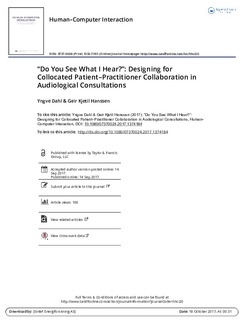| dc.contributor.author | Dahl, Yngve | |
| dc.contributor.author | Hanssen, Geir Kjetil | |
| dc.date.accessioned | 2017-10-19T11:54:59Z | |
| dc.date.available | 2017-10-19T11:54:59Z | |
| dc.date.created | 2017-10-17T12:58:14Z | |
| dc.date.issued | 2017 | |
| dc.identifier.citation | Human-Computer Interaction. 2017, . | nb_NO |
| dc.identifier.issn | 0737-0024 | |
| dc.identifier.uri | http://hdl.handle.net/11250/2461052 | |
| dc.description.abstract | Patient-centered care encourages active involvement of patients in their own treatment and a collaborative perspective on the relationship between patient and practitioner. However, to achieve constructive patient–practitioner collaboration in medical consultations the partakers need to successfully interact across conceptual boundaries that can impede intersubjectivity, i.e., the construction of shared meanings and understandings in communicative activities. We present a synthesis of a user-centered approach to designing interactive technology supporting collaboration in face-to-face consultations related to audiological (hearing) rehabilitation. Specifically, we focus on the case of hearing aid tuning, and on the design and utility assessment of a prototype sound environment simulator intended to support the process by helping the patient and the practitioner build a joint understanding of the individual patient’s hearing problem and perceived effects of treatment actions. We describe an empirical and qualitative investigation that calls specific attention to the multi-dimensional boundaries involved in collocated patient–practitioner interactions, and to the explorative and situated nature of the consultation as a collaborative problem-solving process. Here, various micro-practices play a key role in gradually forming a better understanding of the problem at hand and in identifying appropriate treatment steps. Our findings suggest that patient–practitioner collaboration can benefit from interactive technology, which is sufficiently flexible or open-ended in terms of use to accommodate, or be appropriated, to the immediate needs of the situation. We argue that designing technology with the aim of enhancing existing practices of intersubjectivity, rather than doing away with them, improves the chances of enriching collocated patient–practitioner interaction and reduces risk of obstructing it. The main research contribution is an increased understanding of the medical consultation as an instance of collocated collaborative work and learning, and the challenges and opportunities that lie in co-designing interactive solutions that can help the patient take an active and contributing part in the situation. | nb_NO |
| dc.language.iso | eng | nb_NO |
| dc.publisher | Taylor & Francis | nb_NO |
| dc.rights | Attribution-NonCommercial-NoDerivatives 4.0 Internasjonal | * |
| dc.rights.uri | http://creativecommons.org/licenses/by-nc-nd/4.0/deed.no | * |
| dc.title | “Do You See What I Hear?”: Designing for Collocated Patient–Practitioner Collaboration in Audiological Consultations | nb_NO |
| dc.type | Journal article | nb_NO |
| dc.type | Peer reviewed | nb_NO |
| dc.description.version | publishedVersion | nb_NO |
| dc.source.pagenumber | 50 | nb_NO |
| dc.source.journal | Human-Computer Interaction | nb_NO |
| dc.identifier.doi | 10.1080/07370024.2017.1374184 | |
| dc.identifier.cristin | 1505162 | |
| dc.description.localcode | © Published with license by Taylor & FrancisGroup, LLC. This is an Open Access article. Non-commercial re-use, distribution, and reproduction in any medium,provided the original work is properly attributed, cited, and is not altered, transformed, or built upon in anyway, is permitted. The moral rights of the named author(s) have been asserted. | nb_NO |
| cristin.unitcode | 194,63,10,0 | |
| cristin.unitname | Institutt for datateknologi og informatikk | |
| cristin.ispublished | true | |
| cristin.fulltext | original | |
| cristin.qualitycode | 2 | |

